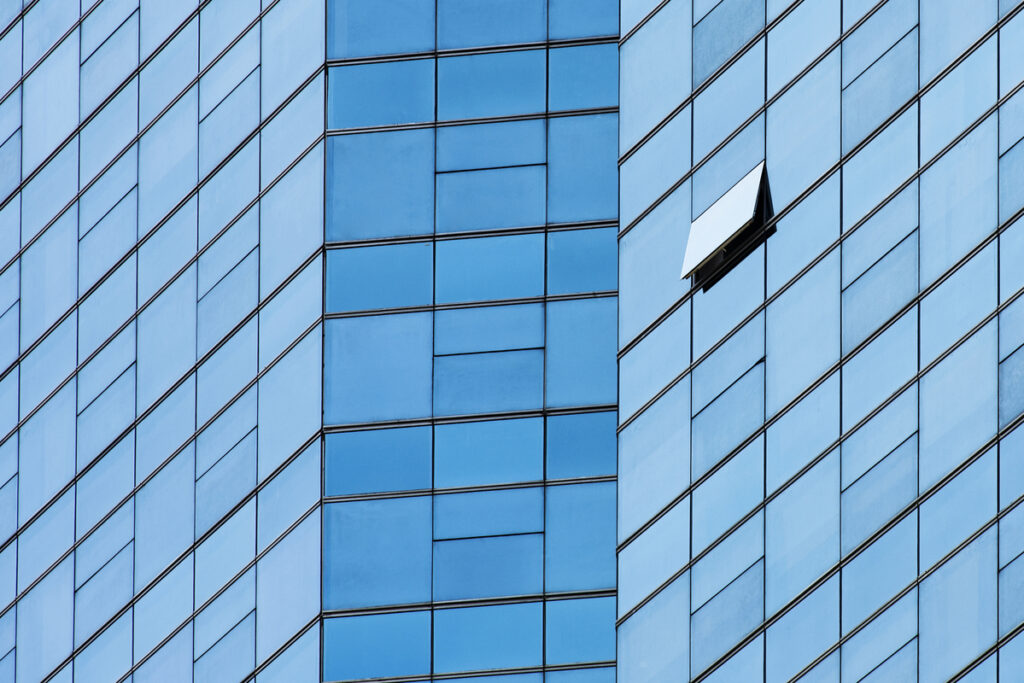Exclusive Neuroject Article: Smart windows, also known as switchable or dynamic windows, stand as a pivotal advancement in the realm of construction technology. By seamlessly integrating modern materials and technology, these windows possess the remarkable ability to alter their visual characteristics in response to external factors like light, heat, or voltage. In the context of contemporary architectural innovation, smart windows hold profound significance due to their inherent potential to heighten energy efficiency, elevate occupant comfort, and fortify a building’s overall sustainability.
The transformative potential of smart windows extends to revolutionizing the way buildings engage with their surroundings, offering architects and designers an exceptional opportunity. Users of these windows find themselves empowered with unparalleled control over key variables including privacy, thermal insulation, and daylight penetration, all thanks to the dynamic nature of these windows.
In essence, adaptive windows are prepared to reshape the landscape of architecture and construction, offering a window of opportunity for more efficient and responsive buildings that serve both the environmental and human needs of our rapidly evolving world.
Table of Contents
Understanding Smart Windows
Switchable windows represent a paradigm shift in modern building design. As technology advances and sustainability becomes a driving force in architecture, the integration of innovative elements like the said windows holds the potential to redefine the way we interact with our built environment. Unlike traditional windows that remain static, these windows possess the remarkable ability to modify their properties in response to external stimulants. This adaptability is facilitated by a sophisticated combination of electronic controls, materials science, and cutting-edge technologies, making them a cornerstone of contemporary building design.

Types of Smart Windows
Smart windows represent a transformative shift in our interaction with the architectural environment. They provide dynamic control over natural light, privacy, and energy efficiency through advanced technologies. Ranging from electrochromic to thermochromic and liquid crystal windows, they offer the adaptability and possibilities inherent in elevating comfort and sustainability in both residential and commercial settings.
1. Electrochromic Windows: Adapting with Precision
Electrochromic windows stand as exemplars of versatility and precision. These windows incorporate electrochromic technology, which empowers them to alter their tint or opacity in response to an electric charge. The result is a seamless transition from clear to shaded, offering occupants exceptional control over natural lighting and privacy. Energy efficiency takes center stage as these windows reduce dependence on artificial lighting and heating, leading to substantial energy savings. Moreover, by addressing glare issues and optimizing privacy levels, electrochromic windows enhance the overall indoor experience, fostering a harmonious relationship between occupants and their surroundings.
2. Thermochromic Windows: Harmonizing with Temperature Dynamics
Thermochromic windows embrace the inherent responsiveness of specific materials to temperature variations. These windows adjust their tint according to the external environment’s temperature fluctuations. The result is a delicate equilibrium between solar heat gain and interior comfort. By minimizing excessive solar heat during warmer periods and allowing more sunlight to penetrate during colder stretches, thermochromic windows alleviate the load on HVAC systems. This intelligent thermal management translates into improved energy efficiency and reduced operational costs.
3. Photochromic Windows: Capturing Light’s Essence
Photochromic technology stands out as a creative solution in the attempt to utilize natural light while minimizing the negative effects of UV radiation. These windows use light-sensitive molecules that, when exposed to sunlight, perform a reversible darkening process. Photochromic windows produce an atmosphere that combines illumination with occupant comfort by adjusting the amount of sunshine that enters indoor spaces. This smooth balancing act makes indoor spaces healthier and more pleasurable in addition to saving energy.
4. SPD-SmartGlass: Mastering Dynamic Transparency
Suspended Particle Device (SPD) technology lies at the core of the remarkable innovation known as SPD-SmartGlass. By manipulating microscopic particles suspended within the glass, SPD-SmartGlass offers instantaneous adjustments to light transmission. This dynamic control is harnessed for multiple purposes, including energy efficiency and privacy enhancement. Occupants wield the power to transform these windows from transparent to opaque at will, shaping the ambiance and function of a space with remarkable ease.
Advantages of Smart Windows in Smart Buildings
Among the revolutionary developments in these structures, smart windows emerged as a significant innovation. These adaptable glass solutions provide a range of advantages, including improved energy efficiency, enhanced occupant comfort, optimized natural lighting, and decreased operational expenses.
1. Energy Efficiency and Sustainability
One of the most significant advantages lies in their ability to enhance energy efficiency and promote sustainability. Traditional windows, while serving as portals for natural light, can also introduce excessive solar heat gain, requiring additional cooling from HVAC systems. Smart windows address this issue by dynamically controlling the amount of sunlight that enters a space. Electrochromic windows, for example, can alter their tint in response to changing light conditions, reducing the need for artificial lighting and cooling. This process, known as daylight harvesting, optimizes the use of natural light while minimizing energy consumption. By effectively managing solar heat gain and lighting, these windows contribute to lower electricity bills and a decreased carbon footprint.
Suggested article for reading: Construction HVAC Systems
2. Occupant Comfort and Well-being
The ease and safety of building occupants must be given top priority in architectural design. Adaptive windows are essential in designing spaces that meet these requirements. These windows let people alter their surroundings because of their adjustable qualities. By changing the window tint, excessive glare—often a problem in areas with lots of natural light—can be reduced. This function improves visual comfort while lowering eye strain and fostering a comfortable living or working environment. The dynamic control of natural light also aids in the regulation of circadian rhythms, improving occupant happiness and productivity. Smart windows help create a more comfortable and healthy indoor environment by allowing inhabitants to customize their surroundings.
3. Integration with Building Automation Systems
In the world of adaptive architecture, the smooth incorporation of different technologies is crucial for effective control. Smart windows fit seamlessly into this idea. When connected to building automation systems (BAS), these windows actively contribute to a comprehensive building management strategy. BAS can track variables like occupancy, indoor light levels, and external weather. Using this information, smart windows can instantly modify their characteristics. For example, when sunlight is strong, the windows can darken to avoid excessive heat and glare. Likewise, as daylight diminishes, they can become clearer to optimize natural light.
Suggested article for reading: Building Automation System

4. Architectural Aesthetics and Flexibility:
Smart windows contribute to the aesthetic appeal of a building’s facade. Their dynamic properties offer architects the opportunity to create visually striking structures that respond to changing external conditions. The ability of these windows to change transparency, tint, or opacity adds a layer of dynamism to the building’s appearance. This aesthetic flexibility enables architects to craft ever-evolving structures that adapt to the time of day, weather conditions, and the preferences of occupants. Beyond enhancing the building’s external appearance, this feature adds a novel dimension to architectural design that promotes engagement and curiosity among passersby.

Moreover, the advantages of adaptive windows in smart buildings are multifaceted and far-reaching. From enhancing energy efficiency and occupant comfort to seamlessly integrating with building automation systems and contributing to architectural aesthetics, these windows epitomize the synergy between technology and sustainable design. As the architectural landscape continues to evolve, these windows stand as a testament to the remarkable potential of merging innovation with environmental responsibility.
Suggested article for reading: Sustainable Buildings
Challenges and Solutions
While intelligent windows offer a range of benefits to smart buildings, their integration is not without challenges. Addressing these challenges with innovative solutions is crucial to fully harnessing the potential of these advanced glazing solutions. In this section, the key challenges associated with these windows and present viable solutions to overcome them will be discussed
1. Cost Considerations:
Challenge: One of the primary obstacles to the widespread adoption of adaptive windows is the initial cost. The integration of responsive technologies, specialized coatings, and manufacturing processes drives up the upfront expenses for these windows, often exceeding the cost of traditional windows.
Solution: To address this challenge, manufacturers and designers are actively working on reducing production costs. Technological advancements and economies of scale are gradually driving down the costs associated with the production of responsive materials and components. Additionally, as the market matures, competition is likely to lead to more affordable options for smart windows, making them a viable investment for both commercial and residential buildings.
Suggested article for reading: Construction Cost Estimating
2. Maintenance and Durability:
Challenge: Ensuring the longevity and reliability of intelligent windows is critical, as these windows are expected to operate flawlessly over extended periods. Wear and tear, exposure to environmental elements, and the intricate components within the windows can all contribute to maintenance concerns.
Solution: Collaborative efforts between manufacturers and building professionals are aimed at improving the durability and longevity of smart windows. Robust materials and coatings that resist damage from UV radiation, moisture, and temperature fluctuations are being developed. Moreover, implementing routine maintenance schedules that include inspection and cleaning can extend the lifespan of these windows and ensure their continued functionality.
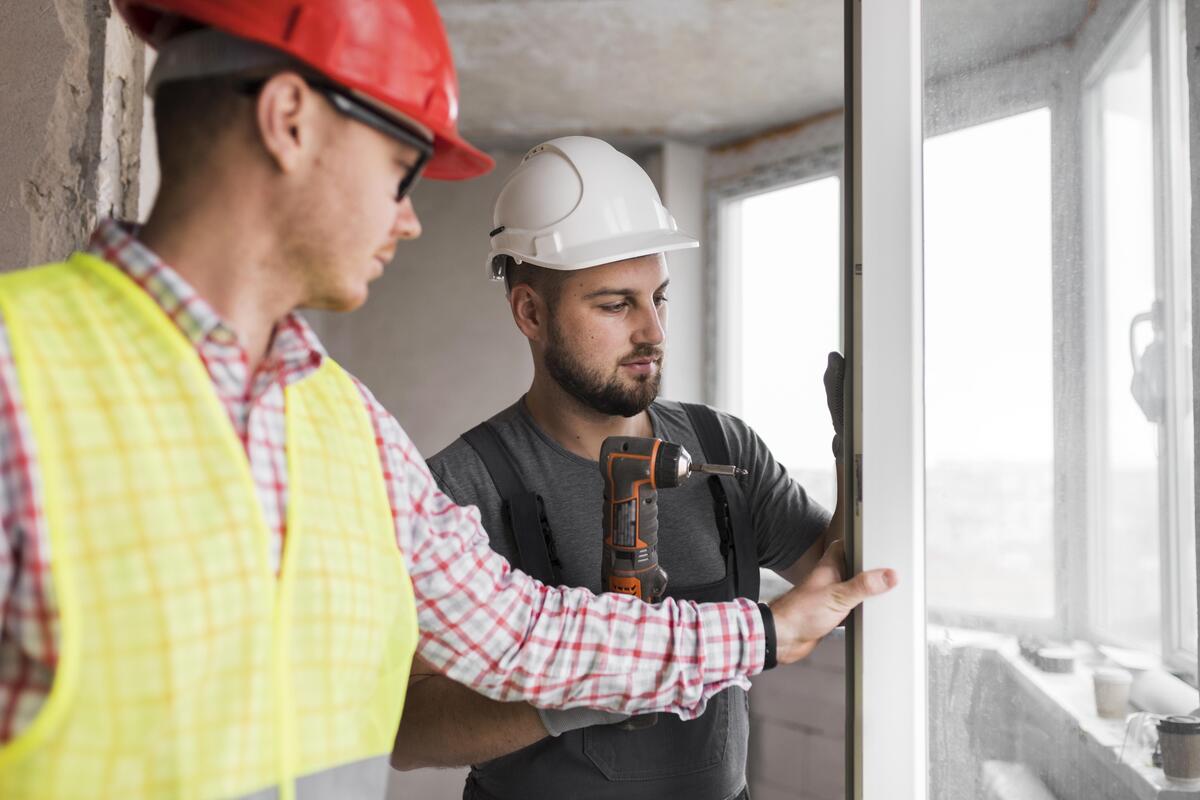
3. Privacy and Security:
Challenge: The dynamic transparency of smart windows raises concerns about occupant privacy and security. While the ability to control window opacity is beneficial, occupants also need assurance that their privacy is not compromised.
Solution: Innovative solutions such as privacy presets and automatic shading based on occupancy can help address privacy concerns. Building automation systems can be programmed to recognize specific user preferences and adjust window properties accordingly. Additionally, integrating these windows with advanced security systems can provide an added layer of protection, allowing occupants to enjoy the benefits of smart windows without sacrificing privacy or security.
Suggested article for reading: Security in Construction site
4. Integration Complexity:
Challenge: The integration of smart windows into building automation systems can be complex, requiring compatibility with various technologies and protocols.
Solution: Standardization efforts within the smart building industry are working to simplify the integration process. The development of open communication protocols allows different systems to seamlessly communicate with each other. Additionally, collaboration between intelligent window manufacturers and building management system providers ensures that the integration process is user-friendly and optimized for performance.
5. Occupant Education:
Challenge: Educating building occupants about the functionalities and benefits of smart windows can be a challenge, as the concept of dynamic glazing is relatively new and unfamiliar to many.
Solution: Building owners, architects, and manufacturers can play a pivotal role in educating occupants about the advantages of these windows. Providing informative materials, user manuals, and interactive demonstrations can help occupants understand how to optimize their experience with these windows. Over time, increased awareness will lead to a more informed and engaged user base.
Case Studies and Real-world Applications
Through the analysis of specific instances and situations spanning various sectors, this exploration delves into concrete results, accomplishments, and obstacles encountered when putting theoretical knowledge into action. By illuminating case studies, our goal is to bridge the divide between theory and application, delivering valuable lessons and insights drawn from real-life encounters. These insights aim to inform, inspire, and guide decision-makers, professionals, and enthusiasts across a multitude of fields.
Case Study 1: Energy-efficient Skyscraper – Edge, Amsterdam
The Edge, a cutting-edge office building located in Amsterdam, serves as a quintessential example of how smart windows can redefine the concept of energy-efficient architecture. Designed by PLP Architecture and developed by OVG Real Estate, this iconic building is equipped with a comprehensive array of sustainable technologies, with intelligent windows taking center stage.
The windows employed in the Edge utilize electrochromic technology to dynamically adjust their tint in response to external conditions. As the sun’s intensity changes throughout the day, the windows seamlessly adapt, modulating solar heat gain and optimizing daylighting. This dynamic approach to fenestration management significantly reduces the building’s reliance on artificial lighting and HVAC systems.
The Edge’s windows are integrated into the building’s wider automation system, allowing occupants to personalize their indoor environment while contributing to energy savings. Occupants can control the tint of their windows through a user-friendly interface, achieving the perfect balance between natural light, visual comfort, and energy efficiency.
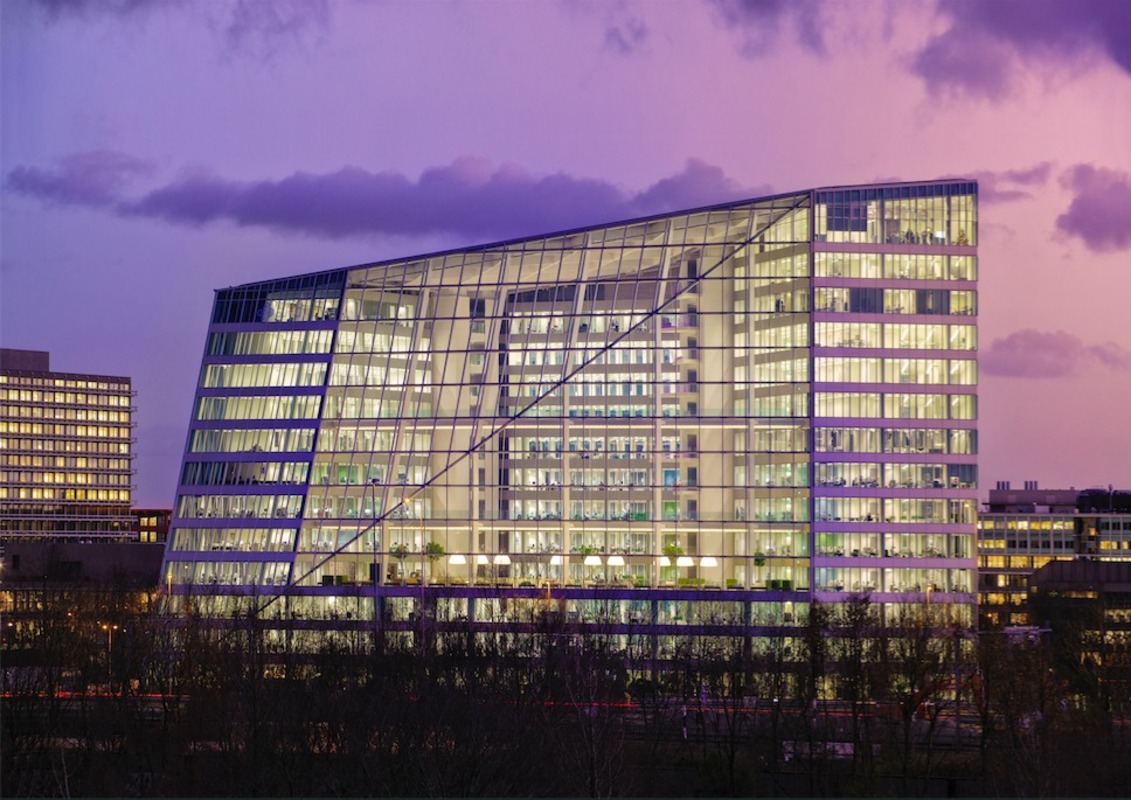
Source: Archdaily
Case Study 2: Smart Office Complex – The Crystal, London
The Crystal, a state-of-the-art sustainable building located in London, exemplifies the multifaceted benefits of incorporating smart windows into a smart office complex. Owned by Siemens and designed by WilkinsonEyre, this iconic structure aims to be a showcase of sustainable urban development.
In this case, smart windows equipped with SPD-SmartGlass technology take center stage. The Crystal’s large facade features windows that can be dynamically adjusted for transparency. By utilizing suspended particle devices, these windows can instantly transition from transparent to opaque, offering privacy and glare control. This feature is especially valuable in meeting rooms and exhibition spaces, where visual privacy and optimal presentation conditions are paramount.

Source: Archdaily
Case Study 3: Al Bahr Towers, Abu Dhabi, UAE: Cultural Inspiration Meets Technological Innovation
The Al Bahr Towers in Abu Dhabi, designed by Aedas Architects, exemplify a remarkable fusion of cultural inspiration and technological advancement. The towers feature an innovative dynamic shading system inspired by traditional Arabic design elements. Comprising triangular panels reminiscent of fish scales, this system adjusts in response to sunlight, opening, and closing to optimize solar exposure.
The Al Bahr Towers’ smart glasses reflect both form and function. By dynamically managing solar heat gain and daylighting, the windows contribute to the towers’ energy efficiency. Additionally, the intricate shading system pays homage to the region’s architectural heritage while showcasing the potential of modern technology in achieving sustainable design goals. This case study demonstrates how smart windows can bridge tradition and innovation, creating a dialogue between the past and the future.
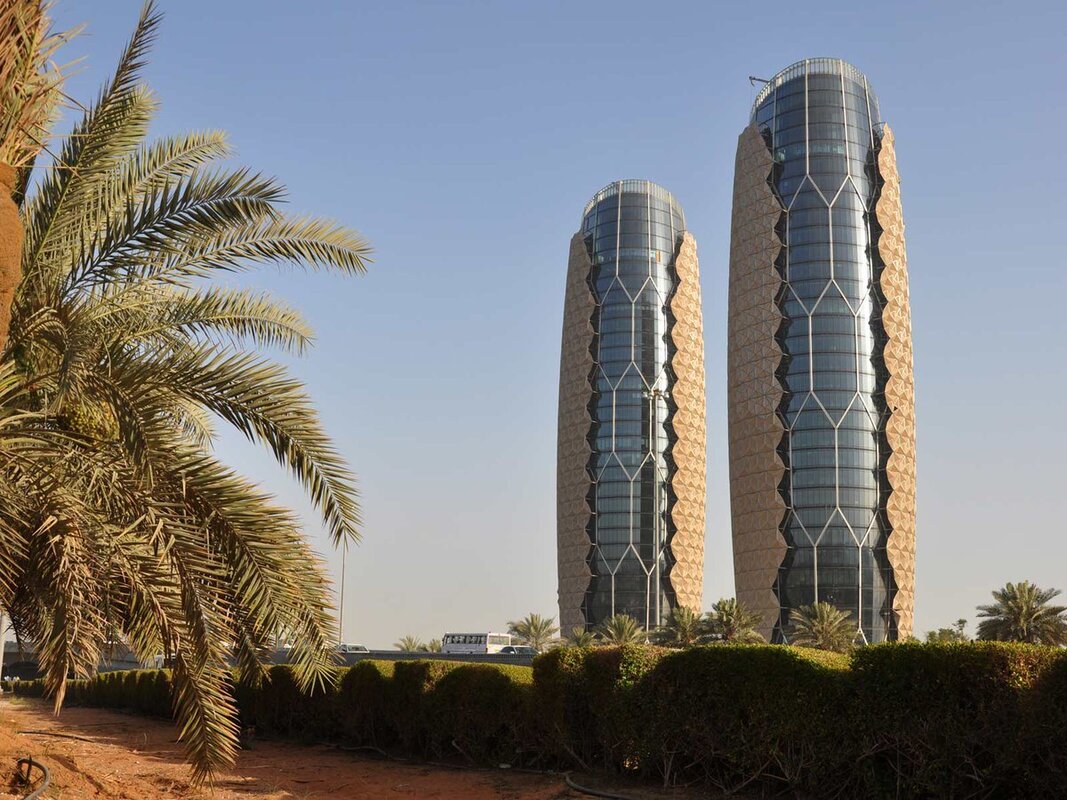
Source: Archdaily
Case Study 4: New York Times Building, New York City, USA: Dynamic Adaptation for Energy Efficiency
The New York Times Building is an emblem of sustainable architecture within New York City. Distinguished by its energy-efficient attributes, this landmark structure employs smart glass technology to elevate its ecological footprint. Notably, the building integrates thermochromic glazing, which modulates its tint in response to temperature fluctuations. This innovative approach showcases a harmonious blend of design and technology, exemplifying the potential for cutting-edge materials to contribute to a greener urban landscape.
During warmer months, the thermochromic windows darken to limit solar heat gain, reducing the demand for air conditioning. Conversely, in colder months, the windows allow more sunlight in to aid heating, maximizing energy efficiency. This dynamic adaptation based on external conditions showcases the practical benefits of smart windows in achieving optimal indoor comfort and energy conservation.
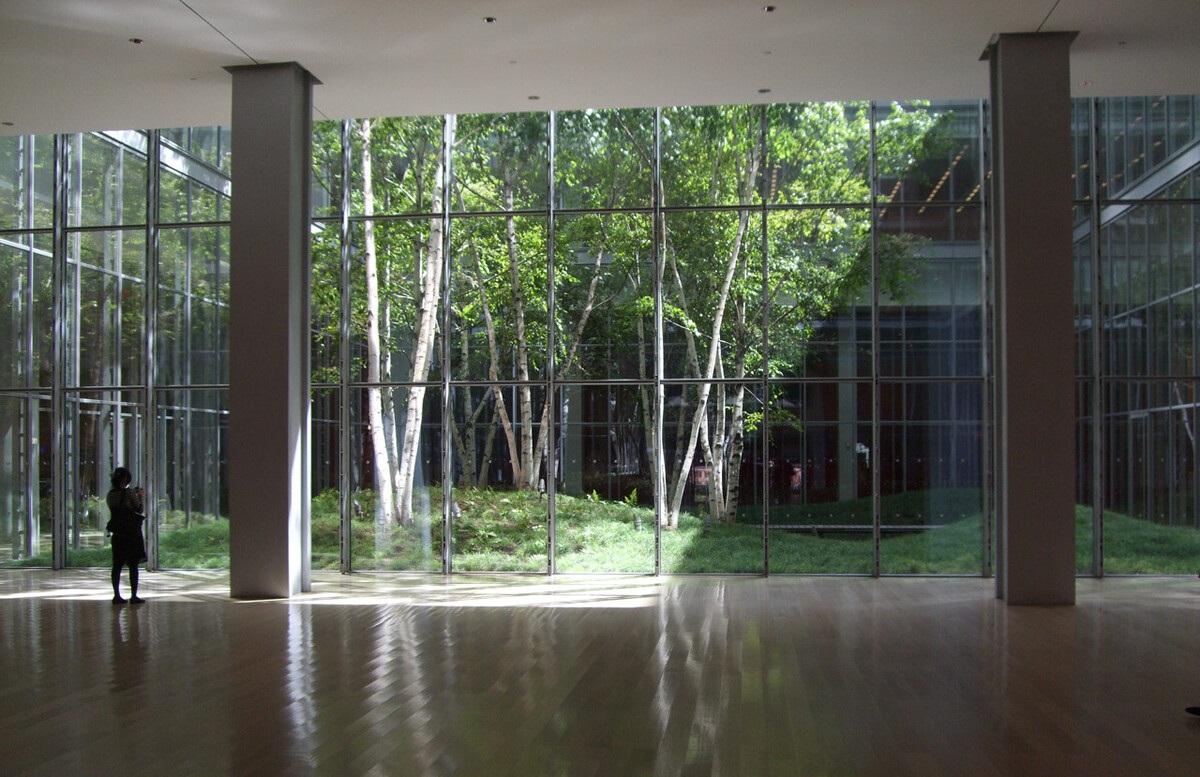
Source: Archdaily
Future Trends and Innovations
The rapid evolution of technology continues to drive innovation in the field of smart windows, promising exciting future trends that will shape the landscape of smart buildings. As we look ahead, several trends and innovations are poised to further enhance the capabilities and applications of smart windows, transforming the way we interact with our built environment.
Nanotechnology Advancements
Nanotechnology is poised to play a pivotal role in the advancement of intelligent windows. The manipulation of materials at the nanoscale allows for precise control over properties such as transparency, color, and thermal insulation. This opens the door to windows that can adapt not only to light levels but also to specific wavelengths, enabling dynamic color changes. Additionally, the integration of nanomaterials could enhance the durability and longevity of these windows, addressing concerns related to wear and tear.
Integration with the Internet of Things (IoT)
The Internet of Things (IoT) revolution is extending its influence to adaptive windows, creating a harmonious ecosystem of interconnected devices. the windows equipped with IoT sensors can seamlessly communicate with other building systems, such as lighting, HVAC, and security. This convergence enables a higher degree of automation, where Windows responds not only to external factors but also to data from various sources. For instance, windows could adjust their properties based on real-time weather forecasts, occupancy levels, or individual preferences.
Suggested article for reading: IoT in Construction
Self-Powering Smart Windows
In an era driven by sustainability, the concept of self-powering smart windows is gaining traction. Researchers are exploring the integration of solar cells into smart windows, allowing them to generate their own energy while modulating light transmission. These self-powering windows can potentially reduce the reliance on external power sources and contribute to the overall energy balance of the building. As solar cell efficiency improves and their integration becomes more seamless, self-powering smart windows could become a standard feature in energy-efficient buildings.
Dynamic Architectural Facades
The integration of smart windows is increasingly influencing architectural aesthetics, and this trend is poised to evolve further. The concept of dynamic architectural facades is gaining momentum, with buildings featuring facades that respond to changing light conditions, weather patterns, or even user interactions. As smart windows become more versatile in terms of design and functionality, architects will have greater creative freedom to design facades that not only enhance energy efficiency but also contribute to the visual identity of a building.
Enhanced User Interaction
The future of smart windows will likely see enhanced user interaction through intuitive interfaces and augmented reality (AR). Occupants may use AR devices to interact directly with their windows, adjusting properties in real-time through gestures or voice commands. This intuitive interaction fosters a deeper sense of control and engagement with the indoor environment.
Suggested articles for reading: Virtual Reality in Construction | Augmented Reality in Construction
Conclusion
In concluding this comprehensive exploration, the significance of smart windows in modern buildings is unmistakably clear. These dynamic, adaptable windows stand as an embodiment of architectural innovation, energy efficiency, and occupant well-being. Their ability to seamlessly control natural light, regulate interior temperature, and enhance privacy not only redefines building design but also elevates the quality of human experiences within these spaces.
The journey through the various facets reveals a landscape teeming with possibilities. From energy savings to improved occupant comfort, the advantages they offer are profound. Therefore, as we move forward, it is vital to encourage broader adoption and integration of adoptable windows in upcoming architectural projects. By embracing these technological marvels, we can forge a path toward more sustainable, responsive, and user-centric buildings.
Adaptable windows serve as threads in the broad tapestry of architectural evolution, tying together beauty, usability, and environmental awareness. Beyond merely being pieces of glass, they have the power to change the way we perceive and interact with the built environment. They permanently alter the architectural picture with every change in hue, light modulation, and comfort enhancement. It is obvious that they will play a crucial part in influencing a future where buildings effortlessly adapt to our needs and the environment.
In essence, smart windows encapsulate the essence of architecture’s ability to blend technology, aesthetics, and human well-being. As we bid farewell to this exploration, let us remember that every pane of glass holds the potential to transform a space into a sanctuary of efficiency, sustainability, and comfort. The journey towards smarter, more responsive buildings has begun, and these kinds of windows are leading the way with transparency and innovation.
Resources:
IntelligentGlass | smithsonianMag | KeyMicroSystems
For all the pictures: Freepik | Archdaily

